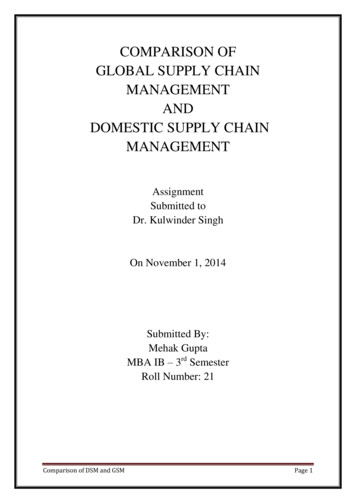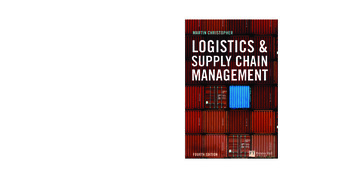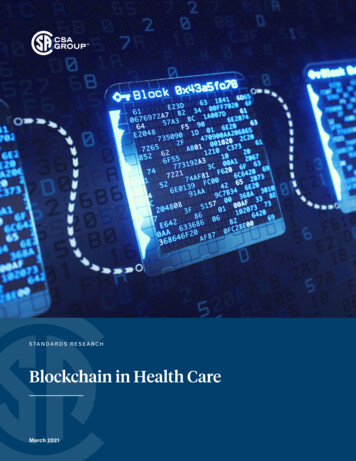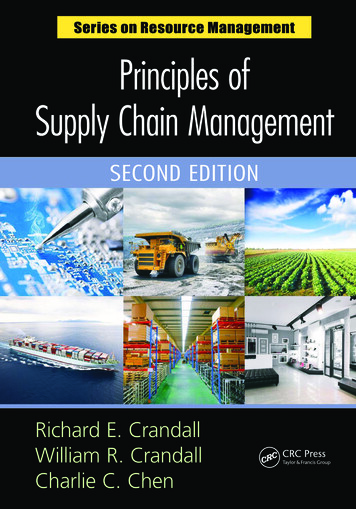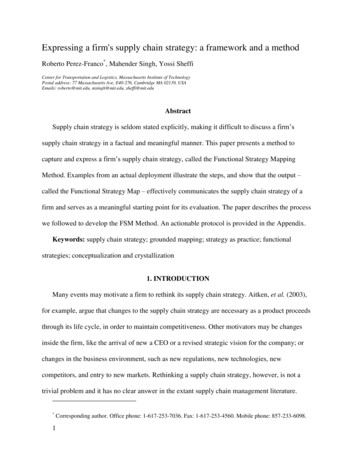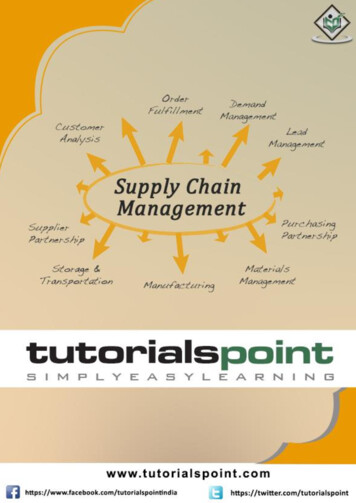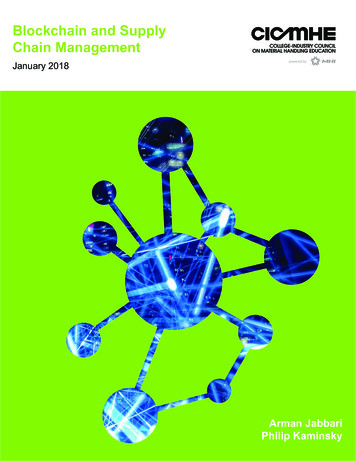
Transcription
Blockchain and SupplyChain ManagementJanuary 2018Arman JabbariPhilip Kaminsky
Blockchain and Supply Chain ManagementArman Jabbari Philip KaminskyDepartment of Industrial Engineering and Operations ResearchUniversity of California, BerkeleyJanuary 2018
AbstractMany authors have explored the potential impact of blockchain on supply chainmanagement, and indeed, many articles in the popular press extol the potentialof blockchain to impact the supply chain. In this white paper, we argue that whileblockchain does have some potential to impact supply chains in the short term,many of the potential blockchain-enabled supply chain impacts will require significant research advances. We identify four categories of issues that researchersmust address in order for many of the interesting proposed blockchain-enabledsupply chain use cases to be feasible. If these issues are addressed, we havelittle doubt that the potential of blockchain-enabled supply chain is enormous.This research was funded by a grant from the College Industry Council onMaterial Handling Education (CICMHE).P. Kaminsky served on CICMHE from 2014-2017.
1. IntroductionBlockchain is a decentralized, distributed database that maintains a continuouslygrowing list of secure data records. It first emerged in the context of Bitcoin,where it serves as a decentralized, distributed digital ledger recording all Bitcointransactions.[1] Bitcoin is a currency that is controlled by the network of usersinstead of by centralized banks. Through the use of Bitcoin, money can betransferred directly.In the traditional banking system, when money is transferred through banks, theyare notified to transfer the money; the bank(s) will send notification and updateaccounts appropriately. The relevant data is stored in a database owned by thebank (or in multiple databases owned by banks), and users only have partialaccess to that data. Users must trust third parties. This has two implications.First, the bank has to make a profit, so in the aggregate, this means less for theother participants. In addition, if some third party or the bank itself manipulatesthe data or commits fraud, it might be challenging for all participants to quicklyand efficiently detect this.On the other hand, the Bitcoin database is decentralized and distributed, so thateveryone has the entire database on his or her own device. These are not copiesof some original database – they are the database itself, and each device syncswith all others. Thus, if a specific device is hacked, or imports incorrect data,the network will not accept this, and will correct the data using other databases.Unless a single entity controls more than half of the devices on the network, it isalmost impossible to delete or edit data. In blockchain, data is stored in blocks ofdata that are linked to the previous blocks. On average, every ten minutes Bitcoincreates a block of data and all user devices will permanently store that data.Each block references the previous blocks, soif someone wants to change data in a block, he must change all previous blocksas well, which is almost impossible.Consider the following quote from [2], which nicely captures the power ofblockchain:
Imagine a piece of paper with a name written on it, and that name entitlesa person to a pot of gold. You put it in a room with 50 doors, and all thosedoors have a lock. But someone could get through one lock and replacethe name on the piece of paper. That is equivalent to centralized database.Blockchain, on the other hand, will duplicate that paper 50 times and put itin 50 different room. In this setting, if someone wants to break the systemand change the name on the papers needs to break [at least 25] rooms atthe same time.[2]One important difference between blockchain and a traditional centralized networkis that blockchain-stored data is un-deletable and un-editable. In a centralizeddatabase, there is always risk of fraud or external hacker attacks, while in ablockchain, the network will work consistently unless an attacker manages totake control of the majority of the network; therefore, a large number of usersalmost significantly reduces the possibility of fraud.Although the Internet makes it inherently challenging to confirm identities andhence to trust other parties, blockchain facilitates trade on the Internet because, ineffect, “the system” ensures trust. In other words, fully secure trade with untrustedparties is possible. This property enables the removal of third-parties in manysystems. “The blockchain is an enabling technology,” explains Dan Burrus. “Thismeans that you don’t need a third-party any more. The network itself replaces thethird-party institution. Therein lies the disruption. Whenever there is a third-partyinvolved to produce a transaction, the blockchain could replace it.” [3] “[S]incethe whole system is running transparently, the system is absolutely open sourceand there is no need for trust among every single node and any node can nevercheat other nodes.” [4]Blockchain is also sometimes known as the “Internet of value” [5] – its advocatesbelieve that it can revolutionize almost every industry. While blockchain is findingits way into a variety of different industries, including fine art, luxury goods,pharmaceuticals, medical devices, and jewelry, for anti- counterfeiting andtracking, and import/export, as well as real estate, etc., for record-keeping, manysuggest that blockchain can make a groundbreaking impact on supply chainmanagement (see, for example, [6, 7, 8]). Imagine using the concepts behindBitcoin to remove the need for banks in the supply chain – in principle, this couldallow everyone to trade directly through Internet. Using blockchain, one couldtrade directly with unknown parties, and remain anonymous. Or at least, that’swhy in some supply chain circles blockchain is touted as the next big thing.Clearly, the 40 trillion supply chain market is at the very least an interestingpotential use case for blockchain in the future. [9]Our focus in this white paper is on the challenges of using blockchain in supplychain (which we call blockchain-enabled supply chain). From out point of view,blockchain currently is a more effective component of financial systems than ofmany physical systems, although we should point our that some authors evenquestion the value of blockchain in a financial context. For instance, Grym[10] points out while Bitcoin solved double-spending problem, it has not evenattempted to solve the price stability problem and it is not clear whether or notcentral banks are the only solution to this problem. Furthermore, blockchain doesnot necessarily scale well. The volume of transactions that the Bitcoin network can
handle every second is roughly ten thousand times less than payment networkslike VisaNet.2. PreliminariesVarious authors have explored the potential impact of blockchain on supply chainmanagement, and indeed, many articles in the popular press extol the potential ofblockchain to impact the supply chain in the short term. For example: Jeremy Wilson, vice-chairman of Barclays Corporate Banking, points outthat blockchain can reduce supply chain paper work. He mentions the firstblockchain-based trade-finance deal. The process, from issuing to approvalof the letter of credit, usually takes between seven and 10 days, but could bereduced to less than four hours.[11] The potential lead time reductions existmore broadly in global supply chains—import, export, and port documentationcould all be expedited. Hofmann et al. [12] claim using blockchain in supply chain finance couldexpedite processes and lower the overall costs of financing programs. Forinstance, blockchain could simplify payment insurance methods, decreasingthe need for letters of credit and therefore reducing transaction fees, increasingspeed and transparency, and so on. Some individual products are challenging to duplicate, and individual itemsare relatively easy to identify. In these cases, the key to supply chainmanagement involves establishing provenance of items being traded, andblockchain can ensure a transparent, secure, un-editable and un-deletableprovenance which could help all parties in the supply chain.While the potential of these impacts and applications to reduce costs and expeditesupply chain tasks should not be minimized, these are hardly path-breakingchanges to current supply chain operations. However, much of the discussion ofthe impact of blockchain on supply chain management is more forward-looking;not so much exploring how blockchain could impact supply chain today, asfocusing on potential future supply chains.Tapscott and Tapscott consider the possibilities of using blockchain technologyfor the end-to- end supply chain in their book, Blockchain Revolution [5]. Theyexplain that Smart Contracts (which we explain below) will enable companies tocontract for price, quality, and delivery dates with just a few clicks of mouse, andsuggest many other ways that blockchain can impact supply chain management.Indeed, many similar ideas can be found in articles written in the past two years.However, all of these are presented at a relatively conceptual level, so it’s difficultto assess how practical these scenarios actually are. Later, we discuss limitationsof current Smart Contracts, and the innovations that we believe are necessary forthem to significantly impact supply chains.Alsmiller [13] suggests that blockchain can be used to track items from suppliersto ensure that products are genuine and accurately described and safely andcorrectly transported. Williams and Gerber [14] also discuss the benefits thattransparency will bring to the supply chain, focusing on how blockchain will allowus to see where our food was grown. In principle, we could track each ingredientin our food from its origin, so that we could, for example, understand whether thebottle of olive oil we just bought is 100% olive oil, or if it is blended with other types
of oil. According to Project Provenance Ltd [15], since every transaction along theblockchain-enabled supply chain is auditable, smart phone applications will beable to display all relevant information to the consumer in real time, and crucially,this information can be completely trusted. However, many hurdles currently existthat make using blockchains this way challenging if not impossible—we discussthese below.Several researchers have also considered the application of RFID to agri-foodtraceability. Tian [4] specifically explores the potential of an agri-food supply chainenabled with RFID tags and blockchain technology. He highlights an importantquestion that has not been considered previously: “whether the informationshared by supply chain members in the traceability systems can be trusted.”He also claims that RFID and blockchain can together improve the efficiencyand reliability of the agri-food supply chain, because he believes the biggestproblem in traditional centralized supervision of the agri-food supply chain is “[M]onopolistic, asymmetric and opaque information system which could result in thetrust problem, such as fraud, corruption, tampering and falsifying information.”While Tian highlights an important concern, as we discuss later in this whitepaper, it is unclear how his solution can fully address this concern.Each of these visions of future blockchain-enabled supply chains raise importantquestions. Indeed, these and similar views suggest that markets will no longerneed third parties to preserve trust and ensure quality, and as a consequence,prices will decrease. Blockchain will provide the opportunity to track every singlepart of each good to its origin. At a fundamental level, this is the benefit thatmany pundits claim for blockchain-enabled supply chains. In our view, blockchainand related technologies will need significant enhancement for these visions tobecome reality. We discuss the key challenges that need to be overcome later inthis white paper.3. “Pure” Blockchain and Supply ChainRecall the time when supply chain management was first entering the popularconsciousness—it seemed that everyone had a different definition andunderstanding of this concept. Two authors could discuss two entirely differentthings and call them supply chain management. Something similar to this currentlyexists in the blockchain space.To emphasize the difference between blockchain and similar concepts, we listcharacteristics that are inherent in what will call “pure blockchain” to highlight thisdifference: pure blockchain is a distributed, decentralized database that maintaina continuously growing list of secure data records without the need for trustedthird-parties oversight or admission control to the system.Blockchain can make the most impact when it ensures trust via system design,rather than through verification of players/nodes. Hence, it is unlikely to lead topathbreaking changes in supply chain management if it doesn’t eliminate theneed for trusted parties in the network.To see this, consider a setting where a single party owns all nodes in the blockchainnetwork; would that party benefit from using blockchain? Does blockchain
add any value in this setting over what can be accomplished using distributeddatabases or centralized databases? We believe the answer in general is NO.(Here, blockchain would simply be a database technology.)Although one of the key defining characteristics of blockchain is its distributeddatabase, a distributed decentralized database is not equivalent (evenconceptually) to pure blockchain.Many authors discuss the concept of private blockchain, which is a closed systemthat features a decentralized, distributed database. A private blockchain requirespermission to join issued by a third party. The third party who gives permissionsto different users needs to be trusted by the entire system; otherwise, it can addso many untrusted nodes to the system that the system can break down, andchanges can be made to stored data.Recall the original point of pure blockchain—to ensure trust in the system whileremoving the need for third parties who do not add value beyond ensuringtrust. Private blockchain, on the other hand, needs trusted third-parties to addnodes to the system. If such a party exists, an integrated centralized databasecould be used for this type of system. While some argue that blockchain-basedprivate networks might be marginally cheaper or more secure, this is a far cryfrom the benefits that have been claimed. Indeed, from our perspective, privateblockchain might add little value over a trusted integrated database. Interestingly,many of the suggested potential use cases for blockchain-enabled supply chainfocus on private blockchain, although we believe that a private blockchain is afundamentally different concept from blockchain as it is commonly defined.Pure blockchain is also not equivalent to public blockchain. Public blockchainsare distinguished based on who can access the system, where users do notneed any permission to join the network while pure blockchains are distinguishedbased on the absence of trusted third parties.3.1 Using Pure Blockchain in Smart ContractsSmart Contracts are computer codes/programs that control the transfer of digitalcurrencies based on predefined conditions. For example, consider a SmartContract for betting on a game. After the result are revealed, there is no needfor payment since the system will transfer the digital money from the loser to thewinner automatically. Many articles have been written about blockchain-basedSmart Contracts, but supply chains typically involve the physical flow of productsfrom initial suppliers to end customers, and in this regard, the most importantdifference between supply chains and financial institutions involves the existenceof physical products. While various authors (such as Tapscott and Tapscott[5]) have claimed that blockchain-based Smart Contracts allow companies todevelop payment, release date, and even quality-based contracts, all of theserequire verification of some kind to ensure that the proper amount of the properquantity of materials have been delivered. Furthermore, as we discuss below, itisn’t clear at all that cur- rent barcode/RFID-tag/3D-stamp/sensor technology issufficient to provide this verification. In addition, the nature of supply chains issignificantly more complex than the straightforward examples typically given forSmart Contracts. Indeed, it seems that given current technology, Smart Contractswill need trusted third-parties to be used in most supply chain applications, so
they don’t immediately fit into a pure blockchain framework. Research will beneeded to overcome this limitation, as we discuss below.3.2 Using Pure Blockchain for Track and TraceThe notion of being able to trace ingredients of any food or product back to itsorigin is very compelling. For example, if one is interested in eating organic foods,it could be valuable to be confident in food’s origins. Although the use of blockchainto achieve this seems appealing, it isn’t immediately clear how to ensure trust insuch a system. How would the data be imported into the system? How would itprevent a party in the supply chain from committing fraud? How would this hugeamount of data be stored in all devices? According to Tian [4], RFID together withblockchain renders trust unnecessary. He explains: “since the whole system isrunning transparently, the system is absolutely open source and there is no needfor trust among every single node and any node can never cheat other nodes.”This point of view is consistent with many other blockchain-enabled supply chainarticles, but in our opinion misses a key point.Note that transparency in blockchains refers to data and digital ledgers; it is notabout products. If we have a data in the database that says our factory boughta hundred ton of olives of grade A quality, no one can delete or edit this data;however, the olives themselves can be switched with olives of inferior quality.In addition, there are likely to be non-blockchain-based markets and outlets forolives, and reliably integrating trades in these markets with blockchain data islikely to be complex. At a very high level, the key goal of blockchain-enabledsupply chains is to obtain 100% certainty of provenance without the need fora trusted third-party; In this case, however, the lack of a trusted third-party andinspections in the network only encourages (or at least, doesn’t discourage) fraud.4. Blockchain CAN revolutionize Supply Chain Management IFthe following problems are addressedDespite the concerns we have raised, we are optimistic about the future of pureblockchain-enabled supply chains—we believe that the solution to the followingopen questions will revolutionize blockchain-enabled supply chains. Indeed, ourgoal in preparing this white paper is to encourage researchers to explore thefollowing questions: How can physical products be linked to the digital ledger? How can blockchain-enabled networks be linked to other external markets? How can blockchain be enhanced to account for complicated supply chainstructures? How can enough space be reserved to store the amount of informationrequired by supply chains?4.1 Problem 1: How can physical products be linked to the digital ledger?Bitcoin is a digital currency and each digital coin is attached to its digital ledgerby definition. In other words, Bitcoin is not separable from its digital ledger.However, supply chains consist of physical products, equipment and materialswhich are separate or separable from their ledgers. If we want to use blockchainfor handling and tracing products to their origins, we need to find a way to attachdigital ledgers to the physical products.
According to Kim and Laskowski [16], “Internet-aware sensors capture finelygranular real-time data about products and environment characteristics as wellas location and timestamps throughout the supply chain. So, lack of a digitalfootprint may no longer be an issue. Furthermore, distributed, shared databasesusing blockchain technologies promise to offer highly secure and immutableaccess to supply chain data.”Unfortunately, currently available technologies such as barcodes, RFID-tags,3D-stamps, and sensors, have two significant limitations. Much of this technologyis duplicable. Consider, for example, an RFID on an original product or a barcodeon a pharmaceutical product. A criminal can duplicate the RFID or copy thebarcode and put it on thousands of fake products. In addition, much of thistechnology can be removed and replaced. Consider a sensor in a truck that iskeeping track of the temperature of the foods. These kinds of sensors are used toensure foods are not exposed to temperatures outside of the allowable range (sothat for example, fruits do not glaciate in low temperatures, or meat or wine don’tspoil in high temperatures, etc.). A criminal could potentially relocate the sensorsto a small constant-temperature container, and this fraud could never be found.Effectively linking physical products with digital ledgers could solve most of theaforementioned issues and bring many opportunities to a variety of industries. Theappropriate technology could truly smooth the way for expansion of blockchainenabled supply chain.4.2 Problem 2: How can blockchain-enabled networks be linked to otherexternal markets?Bitcoin cannot be used in any platform other than the blockchain network. InBitcoin, all transactions are traceable; however, this is in general not true in thesupply chain.Figure 1: Some of the fraud opportunities when current barcode/RFID/3D-stamps/sensortechnology is used in blockchain-enabled supply chain.Consider, for example, an olive oil manufacturer. If there were no market otherthan the blockchain network, it would be possible to analyze inputs and outputs toverify claims regarding purity, so the manufacturer would be prevented from mixingolive oil with other kinds of oil and claiming the olive oil is pure. Unfortunately,even if we solve ”Problem 1” above, the system cannot ensure customer that thecompany is selling pure olive oil, because other markets and sales opportunitiesexist, and the firm can sell some of their olive oil (and buy other kinds of oil toblend with the remaining oil) without being tracked; in other words, the entiremarket is not integrated. Figure 2 depicts this fraud opportunity.
Figure 2: A fraud opportunity due to external markets not integrated into the blockchain.It would be interesting to explore the ways that a blockchain network and othernon-blockchain- based markets could interact.4.3 Problem 3: How can blockchain be enhanced to account for complicatedsupply chain structures?In Bitcoin, all transactions are one-to-one; assembly, disassembly, transformation,waste, break- down, defect and other typical supply chain activities andcharacteristics are not relevant to the Bitcoin network.In contrast, relationships are often not one-to-one in supply chain. Considera factory that assembles a set of parts. How would the blockchain networkcapture this assembly? If a factory ships assembled products to another node inthe network, how would the data be stored? How could the system distinguishbetween shipping a kit of unassembled parts from shipping the assembled part?Similar, consider waste. When a factory cuts parts from a sheet of metal, whathappens to the scraps? Are they useful for cutting other parts? Will they bedisposed of? How can this data be stored? Similar issues arise with trackingdivergent supply chains, defects, breakdowns, transformations, and so on.Figure 3: The challenges of tracking scrap and transformation in supply chains.These kinds of relationships in the supply chain are more complex than the simpletransactions in Bitcoin, and the blockchain that we know from Nakamoto’s paper[17] is not designed to handle the sorts of complex relationships often relevant tosupply chains. Research is needed to overcome these limitations.4.4 Problem 4: How can enough space be reserved to store the amount of
information required by supply chains?Bitcoin requires an amount of disk space that is increasing approximately everyten minutes. Based on the data presented in [18], its required disk space hasincreased 26 GB in 2015 and 41 GB in 2016. Consider that blocks in Bitcoinsave only transactions, while in the context of supply chains, we may need tostore product details, manufacturing specifications, machines and workers thathave contributed to the manufacturing, and many other details (for instance, thevolume of documentation for just a shipment of roses from Kenya to Rotterdamcan generate a pile of paper 25cm high [11]). There is a tremendous amountof data for each product and distributing all data among all parties may not bepossible. On the other hand, saving this data on central servers cannot ensuretrust (and if it can, why use blockchain?). Similarly, sharing data with only a fewparties in the network will require a third-party to manage data sharing.It is an interesting research problem to find a reasonable way to manage sharingthis data.5 ConclusionThus, for blockchain to have a significant impact on supply chain management,it has to eliminate the need for trusted third parties, and to be adapted to thespecific needs to supply chains, both in terms of data requirements, and in termsof the potentially complex structures of supply chains. We believe that in order forblockchain-enabled supply chain technology to reach its potential, and indeed, formany of the interesting proposed blockchain-enabled supply chain use cases tobe feasible, technology must be developed to adapt and extend pure blockchain.If it is, we have little doubt that the potential here is enormous.
References[1] Wikipedia contributors, “Blockchain,” Wikimedia Foundation. [Online]. Available: https://en.wikipedia.org/w/index.php?title Blockchain&oldid 741151510.[2] M. L. Jay, “Building Better Supply Chains with Blockchain,” MHI Solutions, Q2, pp. 20–26, 2017. [Online] 217/index.php?startid 90#/20.[3] K. Benning, “Blockchain Consumerism,” Shop!Association, 16-Mar-2016. [Online]. Available: ism/.[4] F. Tian, “An agri-food supply chain traceability system for China based on RFID & blockchain technology,” 2016 13thInternational Conference on Service Systems and Service Management (ICSSSM), Kunming, 2016, pp. 1-6. [Online]Available: 24/.[5] D. Tapscott and A. Tapscott, How the Technology Behind Bitcoin Is Changing Money, Business, and the World. NewYork: Portfolio Penguin, 2016.[6] E. Camerinelli, “Blockchain in the Supply Chain,” Finextra, 13-May-2016. [Online]. Available: ain-in-the-supply-chain.[7] L. Parker, “Ten companies using the blockchain for non-financial innovation,” Brave New Coin 20-Dec-2015. [Online].Available: the-blockchain-for-non-financial-innovation/.[8] R. Migrov, “The Supply Circle: How Blockchain Technology Disintermediates the Supply Chain,” ConsenSys, 09-Mar2016. [Online]. Available: hain-6a19f61f8f35.[9] L. Parker, “Blockchain tech companies focus on the 40 trillion Supply Chain market,” Brave New Coin 02-Feb-2016.[Online]. Available: .[10] A. Grym, “The payments innovation that will disrupt everything except payments,” LinkedIn, 08-Dec-2016. [Online].Available: -disrupt-everything-except-aleksi-grym.[11] W. Lehmacher, “Why blockchain should be global trade’s next port of call,” World Economic Forum, 23-May-2017.[Online]. Available: ports-global-trades/.[12] E . Hofmann, U. M Strewe, and N Bosia, Supply Chain Finance and Blockchain Technology: The Case of ReverseSecuritisation. Cham, Switzerland: Springer Nature, 2018. Available: [13] C . Alsmiller, “Blockchain: The Next Big Thing in the Supply Chain,” Appterra, 2016. Available: ext-big-thing-in-the-supply-chain/.[14] R . Williams, “How Bitcoin Tech Could Make Supply Chains More Transparent,” Coin Desk, 05-31-2015. [Online].Available: uld-make-supply-chains-more-transparent/.[15] “ Blockchain: the solution for transparency in product supply chains,” Project Provenance, 11-21-2015. [Online].Available: https://www.provenance.org/whitepaper.[16] H . M. Kim and M. Laskowski, “Towards an Ontology-Driven Blockchain Design for Supply Chain Provenance,”Intelligent Systems in Accounting, Finance, and Management, vol. 25, issue 1, pp. 18-27, 2016. [Online]. Availablefrom: https://arxiv.org/abs/1610.02922.[17] S . Nakamoto, “Bitcoin: A Peer-to-Peer Electronic Cash System,” 2008. [Online]. Available: https://bitcoin.org/bitcoin.pdf.[18] “Blockchain Size,” Blockchain Luxembourg S.A. Available: https://blockchain.info/ [Accessed: 2016].
the impact of blockchain on supply chain management is more forward-looking; not so much exploring how blockchain could impact supply chain today, as focusing on potential future supply chains. Tapscott and Tapscott consider the possibilities of using blockchain technology for the end-to- end supply chain i

